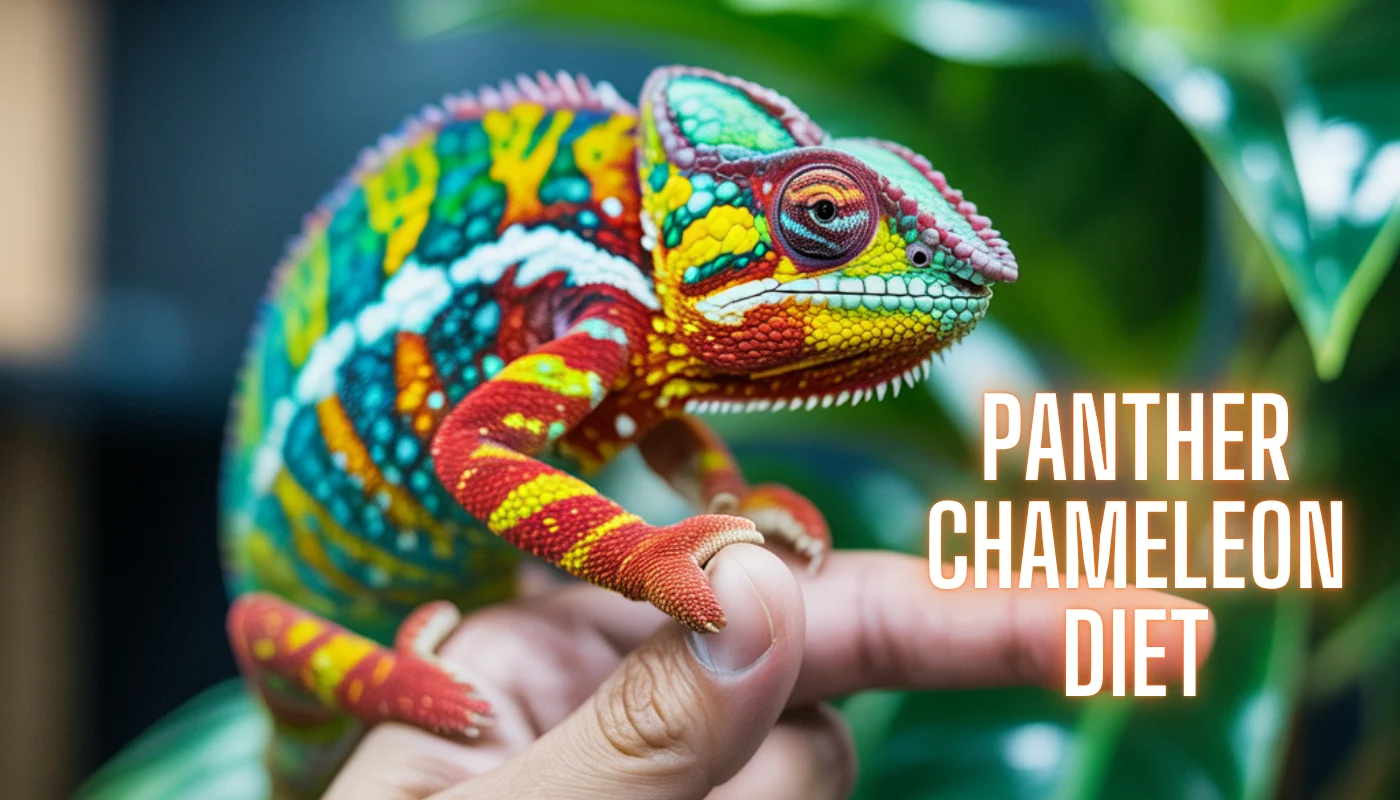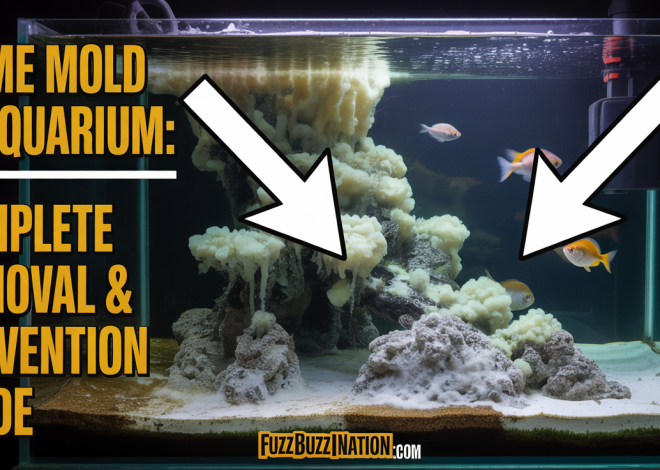
Panther Chameleon Diet: Complete 2025 Feeding Guide
Creating the perfect panther chameleon diet is essential for keeping these magnificent color-changing reptiles healthy and vibrant in captivity. If you’re watching your chameleon refuse food, show signs of nutritional deficiency, or you’re simply overwhelmed by conflicting feeding advice, understanding proper nutrition can make the difference between a thriving pet and costly veterinary bills.
Panther chameleons are fascinating creatures that… well, let’s just say they’re probably some of the pickiest eaters you’ll ever encounter. These arboreal insectivores have evolved very specific dietary needs that many new owners struggle to meet. After consulting with herpetological veterinarians and experienced chameleon keepers, I’ve discovered that proper nutrition requires much more than just throwing crickets into their enclosure.
The ideal feeding plan must provide varied nutrition through live insects, proper supplementation, and careful attention to feeding schedules. You know how some people are very particular about their food? Well, panther chameleons take that to a whole new level—their health literally depends on getting their nutrition exactly right, from insect selection to gut-loading and supplementation.
Understanding Nutritional Needs: More Than Just Bugs
The Insectivorous Nature of Panther Chameleons
Panther chameleons are obligate insectivores, which means their entire digestive system has evolved specifically to process live insects. When planning proper nutrition, it’s crucial to understand that these reptiles can’t survive on commercial pellets or processed foods like some other pets. Their digestive tract, enzyme production, and nutrient absorption are all designed for breaking down the exoskeletons, muscles, and organs of various insects.
I’ve observed that many chameleon health problems stem from well-meaning owners who don’t realize how specialized their feeding requirements need to be. Unlike omnivorous reptiles that can eat fruits and vegetables, panther chameleons struggle to digest plant matter and can actually develop health issues if fed inappropriate foods regularly.
Nutritional Requirements and Metabolism
The feeding plan must provide specific macro and micronutrients that support their unique physiology. These reptiles have high metabolisms compared to many other lizards, which means they need consistent, high-quality nutrition to maintain their energy levels and famous color-changing abilities.
Calcium is particularly crucial in any feeding regimen. These arboreal reptiles need strong bones to support their climbing lifestyle, and females require extra calcium for egg production. Without proper calcium supplementation, panther chameleons quickly develop metabolic bone disease—a painful condition that’s unfortunately common in captivity.
Essential Insects for Balanced Nutrition
Primary Staple Insects
When building the foundation of proper feeding, certain insects should form the backbone of their nutrition. These staple feeders provide balanced nutrition and can be offered regularly without concern.
Dubia Roaches: The Gold Standard Dubia roaches represent perhaps the best single insect you can include in their feeding regimen. These roaches contain excellent protein-to-fat ratios, are easy to gut-load with nutritious foods, and have soft exoskeletons that digest easily. They can safely constitute 40-45% of your chameleon’s total insect intake.
What makes dubias particularly valuable is their consistency. Unlike crickets, which can die suddenly or become aggressive, dubia roaches are hardy, quiet, and virtually odorless. They also live much longer, making them cost-effective for regular feeding.
Crickets: The Reliable Classic Crickets have been a staple in feeding chameleons for decades, and for good reason. They’re widely available, reasonably priced, and provide solid nutrition when properly gut-loaded. Crickets can make up 35-40% of a balanced feeding plan.
However, crickets do have some drawbacks. They’re noisy, short-lived, and can become aggressive toward each other if overcrowded. Some crickets may also bite your chameleon if left uneaten in the enclosure, so remove any extras after feeding time.
Silkworms: The Calcium Champions Silkworms are exceptional additions to any feeding regimen due to their naturally high calcium content. These soft-bodied caterpillars are easy to digest and can comprise 35-40% of your chameleon’s insect intake. They’re particularly valuable for growing juveniles and reproductive females who need extra calcium.
The main challenge with including silkworms in feeding schedules is availability and cost. They’re more expensive than crickets or roaches and have a shorter shelf life, but their nutritional benefits often justify the extra expense.
Quick Comparison: Best Insects for Feeding Chameleons
| Insect Type | Diet Percentage | Nutritional Benefits | Availability | Gut-Loading Ease |
|---|---|---|---|---|
| Dubia Roaches | 40-45% | High protein, balanced fat | Moderate | Excellent |
| Crickets | 35-40% | Well-balanced nutrition | High | Good |
| Silkworms | 35-40% | High calcium, easy digestion | Low | Fair |
| Hornworms | Up to 20% | High moisture, calcium | Moderate | Good |
| Black Soldier Fly Larvae | Up to 30% | High calcium, small size | Moderate | Excellent |
| Superworms | Up to 20% | High protein, higher fat | High | Good |
Supplemental and Treat Insects for Variety
Beneficial Occasional Feeders
A well-rounded feeding plan includes insects that provide specific benefits but shouldn’t be fed as frequently as staple foods.
Hornworms: The Hydration Heroes Hornworms are excellent additions to feeding schedules, particularly during shedding periods or in dry climates. These large, green caterpillars are about 85% water, making them natural hydration supplements. They’re also rich in calcium and protein, though they should be limited to about 20% of the total intake due to their size and high moisture content.
The bright green color of hornworms often triggers strong feeding responses in panther chameleons, making them valuable for encouraging appetite in reluctant feeders.
Black Soldier Fly Larvae: The Calcium Powerhouses Also known as Nutrigrubs, black soldier fly larvae are becoming increasingly popular in panther chameleon diet planning. These small, soft-bodied larvae contain exceptional calcium levels—often higher than properly supplemented crickets. They can make up to 30% of a balanced panther chameleon diet.
Their small size makes them perfect for younger chameleons or as supplemental nutrition for adults. The larvae are also easier to digest than harder-bodied insects.
High-Fat Treats to Use Sparingly
Some insects should only appear occasionally in a panther chameleon diet due to their high fat content or lower nutritional value.
Superworms: Protein-Rich but Fatty Superworms can be valuable components of a panther chameleon diet when used appropriately. They’re high in protein and readily available, but their fat content means they should be limited to about 20% of total insect intake. Use them as occasional treats or to help underweight chameleons gain condition.
The hard exoskeleton of superworms can be challenging for smaller chameleons to digest, so they’re best reserved for adult animals.
Mealworms: The Controversial Choice Mealworms remain controversial in panther chameleon diet discussions. While they’re widely available and affordable, their hard exoskeletons and poor calcium-to-phosphorus ratios make them less ideal. If used at all, mealworms should comprise less than 10% of the panther chameleon diet and only for adult animals.
Many experienced keepers avoid mealworms entirely, preferring more nutritious alternatives.
Insects to Avoid in Your Panther Chameleon Diet
High-Fat Treats: Waxworms and Butterworms
While waxworms and butterworms are often marketed as chameleon food, they should be used extremely sparingly in any panther chameleon diet. These larvae are essentially “insect candy”—very high in fat with limited nutritional value.
If used at all, these insects should comprise no more than 3-5% of the total panther chameleon diet and only as occasional treats for underweight animals or to encourage feeding in sick chameleons.
Wild-Caught Insects: The Hidden Dangers
Never include wild-caught insects in your chameleon diet. While it might seem natural, wild insects can carry parasites, diseases, or pesticide residues that can seriously harm your chameleon. Stick to commercially bred feeder insects from reputable suppliers.
Dead or Dying Insects
Only live insects should be included in a panther chameleon diet. Dead insects lose nutritional value quickly and can harbor harmful bacteria. Panther chameleons are also stimulated to hunt by movement, so they may refuse dead prey entirely.
Gut-Loading: Maximizing Your Panther Chameleon Diet Nutrition
The Importance of Gut-Loading
Gut-loading is a crucial component of any successful panther chameleon diet strategy. This process involves feeding nutritious foods to your feeder insects 24-48 hours before offering them to your chameleon. Essentially, you’re using the insects as delivery vehicles for nutrients.
A proper gut-loading regimen can dramatically improve the nutritional value of your panther chameleon diet. Well gut-loaded crickets can contain 2-3 times more vitamins and minerals than those fed only commercial cricket food.
Best Gut-Loading Foods
Vegetables for Gut-Loading:
- Collard greens, mustard greens, and kale (high in calcium)
- Squash, sweet potato, and carrots (high in vitamin A)
- Broccoli and green beans (various vitamins and minerals)
Commercial Gut-Loading Products:
- High-quality commercial gut-loading diets designed specifically for feeder insects
- Avoid dog food, cat food, or fish flakes, which can actually decrease nutritional value
Foods to Avoid When Gut-Loading:
- Citrus fruits (can cause digestive upset)
- Tomatoes (too acidic)
- Iceberg lettuce (virtually no nutritional value)
- Processed human foods
Age-Specific Panther Chameleon Diet Guidelines
Hatchling Panther Chameleon Diet (0-3 months)
Baby panther chameleons need frequent feeding with appropriately sized insects. The hatchling panther chameleon diet should consist of:
Feeding Frequency: 2-3 times daily Insect Size: 1/4 inch or smaller Quantity: As many insects as they can eat in 5-10 minutes
Best Insects for Hatchlings:
- Fruit flies (both hydei and melanogaster)
- Pinhead crickets
- Small dubia roach nymphs
- Bean beetles
The hatchling panther chameleon diet is critical for proper development. Undernourished babies often develop into weak adults with ongoing health problems.
Juvenile Panther Chameleon Diet (3-12 months)
Growing juveniles need substantial nutrition to support their rapid development. The juvenile panther chameleon diet should include:
Feeding Frequency: Once daily or every other day Insect Size: 1/4 to 1/2 inch Quantity: 5-10 appropriately sized insects
Recommended Insects:
- Small crickets
- Young dubia roaches
- Silkworms
- Small hornworms
- Black soldier fly larvae
Juvenile growth rates vary significantly, so monitor body condition and adjust the panther chameleon diet accordingly.
Adult Panther Chameleon Diet (12+ months)
Adult panther chameleons need fewer insects but require consistent nutrition for maintenance and reproduction. The adult panther chameleon diet should feature:
Feeding Frequency: Every other day Insect Size: 1/2 to 3/4 inch Quantity: 3-8 insects depending on chameleon size and body condition
Primary Adult Feeders:
- Adult crickets
- Adult dubia roaches
- Silkworms
- Hornworms
- Superworms (occasionally)
Supplementation: The Critical Component of Panther Chameleon Diet
Calcium Supplementation
Calcium is the most important supplement in any panther chameleon diet. These reptiles need calcium at nearly every feeding to prevent metabolic bone disease.
Calcium Without D3: Use at most feedings (4-5 times per week) Calcium With D3: Use 1-2 times per week if providing UVB lighting Calcium With D3: Use more frequently (3-4 times per week) if no UVB lighting
The type and frequency of calcium supplementation in your panther chameleon diet depends on your UVB lighting setup and your chameleon’s age and reproductive status.
Multivitamin Supplementation
A quality reptile multivitamin should be included in the panther chameleon diet supplementation routine 1-2 times per week. This provides essential vitamins that aren’t adequately supplied by insects alone, particularly vitamin A.
Choosing Multivitamins:
- Look for reptile-specific formulations
- Avoid products with excessive vitamin D3
- Stick to established brands with good reputations
Supplementation Schedule Example
Monday: Calcium without D3 Wednesday: Calcium with D3 Friday: Multivitamin Sunday: Calcium without D3
Adjust this schedule based on your specific panther chameleon diet needs and lighting setup.
Hydration in the Panther Chameleon Diet
Natural Drinking Behaviors
Panther chameleons rarely drink from standing water dishes. In the wild, they obtain moisture from rain droplets on leaves, and this behavior continues in captivity. Proper hydration is essential to any panther chameleon diet plan.
Misting Systems: Automated misting provides consistent moisture Dripping Systems: Slow drips encourage natural drinking behaviors Manual Misting: Hand spraying works for smaller setups
Hydrating Insects
Some insects in the panther chameleon diet provide significant hydration:
- Hornworms (85% water content)
- Silkworms (moderate moisture)
- Fresh, well-hydrated crickets and roaches
Dehydrated feeder insects provide poor nutrition and can actually worsen dehydration in chameleons.
Common Panther Chameleon Diet Mistakes to Avoid
Feeding Only One Type of Insect
Many new chameleon owners stick with only crickets, thinking they’re providing adequate nutrition. A monotonous panther chameleon diet leads to nutritional deficiencies over time, even with supplementation.
The Solution: Offer at least 3-4 different insect types regularly, rotating them to ensure variety.
Inadequate Gut-Loading
Feeding insects only commercial cricket food or grain provides poor nutrition. The panther chameleon diet is only as good as what the insects have eaten.
The Solution: Implement a consistent gut-loading protocol using fresh vegetables and quality commercial gut-loading diets.
Over-Supplementation
More supplements don’t always mean better health. Excessive vitamin D3 or vitamin A can cause toxicity issues that are difficult to reverse.
The Solution: Follow established supplementation schedules and avoid mixing multiple products with overlapping ingredients.
Inappropriate Insect Sizes
Insects that are too large can cause choking or digestive impaction. The general rule for panther chameleon diet planning is that insects should be no larger than the space between your chameleon’s eyes.
The Solution: Size insects appropriately for your chameleon’s age and size, erring on the side of smaller rather than larger.
Seasonal Adjustments to Panther Chameleon Diet
Breeding Season Nutrition
During breeding season, both male and female panther chameleons have increased nutritional needs. The panther chameleon diet should be adjusted accordingly:
For Breeding Females:
- Increase feeding frequency to daily
- Provide extra calcium supplementation
- Include more silkworms and hornworms
- Monitor body condition closely
For Breeding Males:
- Maintain regular feeding schedule
- Ensure adequate protein intake
- Monitor for weight loss during territorial behaviors
Winter Feeding Adjustments
Panther chameleons may eat less during cooler months, even in heated enclosures. The panther chameleon diet may need adjustment:
- Reduce feeding frequency slightly if appetite decreases
- Maintain supplementation schedules
- Monitor body condition more closely
- Ensure adequate UVB exposure to maintain appetite
Troubleshooting Panther Chameleon Diet Problems
Loss of Appetite
Appetite loss can indicate various problems, from environmental issues to illness. When a chameleon refuses their normal panther chameleon diet:
Environmental Factors:
- Check temperature and humidity levels
- Ensure adequate UVB lighting
- Verify proper enclosure setup
Dietary Solutions:
- Offer highly palatable insects like hornworms
- Try different insect varieties
- Ensure insects are properly gut-loaded and lively
When to Seek Veterinary Care: If appetite loss persists more than a week or is accompanied by other symptoms.
Nutritional Deficiencies
Signs of poor nutrition despite a seemingly adequate panther chameleon diet:
Metabolic Bone Disease: Soft jaw, bent limbs, difficulty climbing Vitamin A Deficiency: Eye problems, respiratory infections Dehydration: Sunken eyes, lethargy, reduced skin elasticity
These conditions require immediate veterinary attention and dietary adjustment.
Frequently Asked Questions About Panther Chameleon Diet
Can panther chameleons eat fruits and vegetables?
While panther chameleons can technically consume small amounts of plant matter, fruits and vegetables should not be part of their regular diet. Their digestive systems are designed for insects, and excessive plant matter can cause digestive problems. Focus on gut-loading feeder insects with nutritious vegetables instead.
How often should I feed my adult panther chameleon?
Adult panther chameleons should typically eat every other day as part of a balanced panther chameleon diet. Feed 3-8 appropriately sized insects per feeding, depending on your chameleon’s size and body condition. Monitor weight and adjust frequency if needed.
What’s the best single insect for a panther chameleon diet?
While variety is important, dubia roaches are often considered the best single insect for a panther chameleon diet. They provide excellent nutrition, are easy to gut-load, and have ideal protein-to-fat ratios. However, no single insect should comprise more than 45% of the total diet.
Do I need to supplement if I’m gut-loading properly?
Yes, even with excellent gut-loading, supplementation remains essential in any panther chameleon diet. Calcium and multivitamins provide nutrients that can’t be adequately supplied through insects alone, regardless of gut-loading quality.
Can I feed my panther chameleon dead insects?
No, the panther chameleon diet should consist only of live insects. Panther chameleons are stimulated to hunt by movement and will often refuse dead prey. Dead insects also lose nutritional value and can harbor harmful bacteria.
How do I know if my panther chameleon is getting proper nutrition?
A well-fed chameleon on an appropriate diet will have good body condition (ribs not visible but easily felt), bright coloration, clear eyes, and normal activity levels. Regular veterinary checkups can help monitor nutritional status.
What should I do if my chameleon only wants to eat one type of insect?
Some chameleons develop preferences that can limit panther chameleon diet variety. Try offering preferred insects only every few feedings, mixed with other types. Hungry chameleons are more likely to try new foods. Ensure all insects are properly gut-loaded and lively.
Are there any insects that are toxic to panther chameleons?
Avoid feeding fireflies, any brightly colored insects, or insects caught from areas treated with pesticides. Stick to commercially bred feeder insects for safety. Wild-caught insects should never be part of a panther chameleon diet due to parasite and toxin risks.
How much should I supplement female chameleons during egg-laying?
Egg-laying females need increased calcium supplementation in their panther chameleon diet. Provide calcium (with D3) every other feeding and calcium (without D3) at other feedings. Monitor closely for signs of calcium deficiency and consult a veterinarian familiar with chameleons.
Can baby chameleons eat the same insects as adults?
Baby chameleons need much smaller insects in their diet. Hatchlings should eat fruit flies, pinhead crickets, and tiny roach nymphs. Insect size should be no larger than the space between the chameleon’s eyes, which is much smaller in babies than adults.
Creating Your Panther Chameleon Diet Plan
s=”text-lg font-bold text-text-100 mt-1 -mb-1.5″>Weekly Feeding Schedule Template
Monday: Dubia roaches + calcium without D3 Tuesday: Rest day Wednesday: Crickets + calcium with D3 Thursday: Rest day Friday: Silkworms + multivitamin Saturday: Rest day Sunday: Mixed insects + calcium without D3
Adjust this template based on your chameleon’s age, size, and individual needs.
Insect Rotation Strategy
To maintain proper variety in your panther chameleon diet:
Week 1: Focus on dubia roaches and crickets Week 2: Emphasize silkworms and hornworms Week 3: Include black soldier fly larvae and superworms Week 4: Return to week 1 rotation
This ensures consistent variety while maintaining nutritional balance.
Monitoring and Adjustments
Track your chameleon’s response to their diet:
- Weekly weight checks (for adults)
- Monthly photos to monitor body condition
- Notes on feeding response and behavior changes
- Regular veterinary wellness exams
Conclusion: Mastering the Panther Chameleon Diet for Optimal Health
Creating the perfect panther chameleon diet requires attention to detail, consistency, and ongoing monitoring. These remarkable reptiles have evolved very specific nutritional needs that commercial pet foods simply can’t meet. Success comes from understanding their insectivorous nature, providing appropriate variety, and maintaining proper supplementation.
Remember that every panther chameleon is an individual, and the best panther chameleon diet is one that keeps your specific animal healthy and thriving. Start with the guidelines provided here, monitor your chameleon’s response, and don’t hesitate to make adjustments based on their needs.
The investment in creating a proper panther chameleon diet pays dividends in vibrant colors, healthy behavior, and years of fascinating companionship with one of nature’s most remarkable creatures. Take the time to source quality insects, establish gut-loading routines, and maintain supplementation schedules—your panther chameleon’s health depends on these critical aspects of their care.
With patience and attention to detail, you can provide a panther chameleon diet that supports not just survival, but genuine thriving in captivity.


